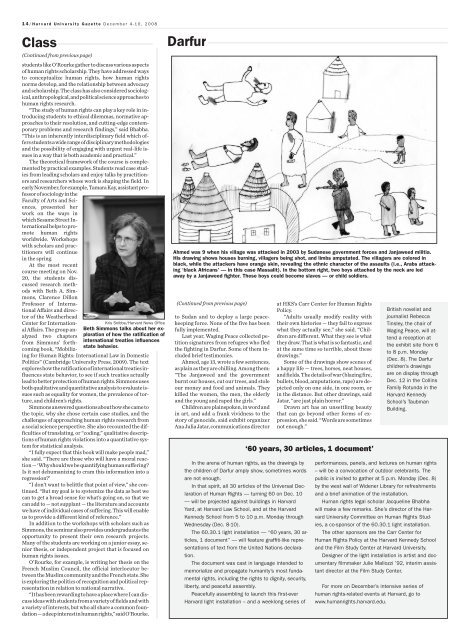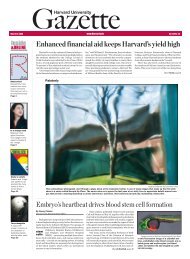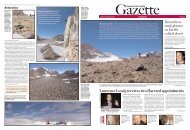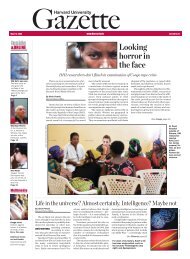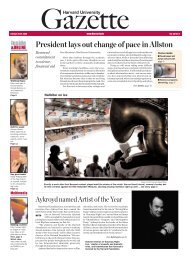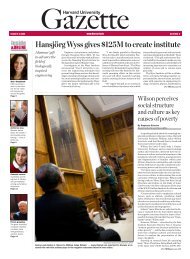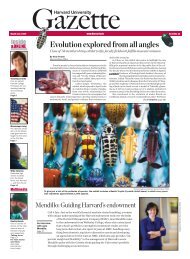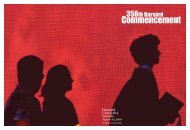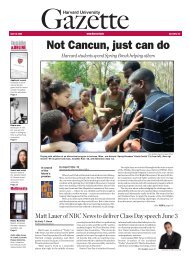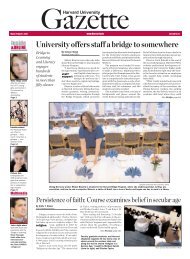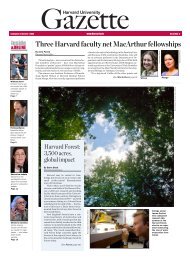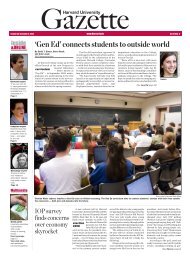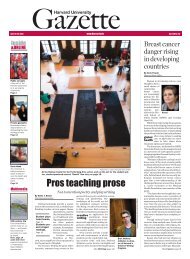Harvard University Gazette December 4-10, 2008 - Harvard News ...
Harvard University Gazette December 4-10, 2008 - Harvard News ...
Harvard University Gazette December 4-10, 2008 - Harvard News ...
You also want an ePaper? Increase the reach of your titles
YUMPU automatically turns print PDFs into web optimized ePapers that Google loves.
14/ <strong>Harvard</strong> <strong>University</strong> <strong>Gazette</strong> <strong>December</strong> 4-<strong>10</strong>, <strong>2008</strong><br />
Class<br />
(Continued from previous page)<br />
Kris Snibbe/<strong>Harvard</strong> <strong>News</strong> Office<br />
Beth Simmons talks about her exploration<br />
of how the ratification of<br />
international treaties influences<br />
state behavior.<br />
students like O’Rourke gather to discuss various aspects<br />
of human rights scholarship. They have addressed ways<br />
to conceptualize human rights, how human rights<br />
norms develop, and the relationship between advocacy<br />
and scholarship. The class has also considered sociological,<br />
anthropological, and political science approaches to<br />
human rights research.<br />
“The study of human rights can play a key role in introducing<br />
students to ethical dilemmas, normative approaches<br />
to their resolution, and cutting-edge contemporary<br />
problems and research findings,” said Bhabha.<br />
“This is an inherently interdisciplinary field which offers<br />
students a wide range of disciplinary methodologies<br />
and the possibility of engaging with urgent real-life issues<br />
in a way that is both academic and practical.”<br />
The theoretical framework of the course is complemented<br />
by practical examples. Students read case studies<br />
from leading scholars and enjoy talks by practitioners<br />
and researchers whose work is shaping the field. In<br />
early November, for example, Tamara Kay, assistant professor<br />
of sociology in the<br />
Faculty of Arts and Sciences,<br />
presented her<br />
work on the ways in<br />
which Sesame Street International<br />
helps to promote<br />
human rights<br />
worldwide. Workshops<br />
with scholars and practitioners<br />
will continue<br />
in the spring.<br />
At the most recent<br />
course meeting on Nov.<br />
20, the students discussed<br />
research methods<br />
with Beth A. Simmons,<br />
Clarence Dillon<br />
Professor of International<br />
Affairs and director<br />
of the Weatherhead<br />
Center for International<br />
Affairs. The group analyzed<br />
two chapters<br />
from Simmons’ forthcoming<br />
book, “Mobilizing<br />
for Human Rights: International Law in Domestic<br />
Politics” (Cambridge <strong>University</strong> Press, 2009). The text<br />
explores how the ratification of international treaties influences<br />
state behavior, to see if such treaties actually<br />
lead to better protection of human rights. Simmons uses<br />
both qualitative and quantitative analysis to evaluate issues<br />
such as equality for women, the prevalence of torture,<br />
and children’s rights.<br />
Simmons answered questions about how she came to<br />
the topic, why she chose certain case studies, and the<br />
challenges of approaching human rights research from<br />
a social science perspective. She also recounted the difficulties<br />
of translating, or “coding,” qualitative descriptions<br />
of human rights violations into a quantitative system<br />
for statistical analysis.<br />
“I fully expect that this book will make people mad,”<br />
she said. “There are those who will have a moral reaction<br />
— ‘Why should we be quantifying human suffering<br />
Is it not dehumanizing to cram this information into a<br />
regression’<br />
“I don’t want to belittle that point of view,” she continued.<br />
“But my goal is to systemize the data as best we<br />
can to get a broad sense for what’s going on, so that we<br />
can add to — not supplant — the literature and accounts<br />
we have of individual cases of suffering. This will enable<br />
us to provide a different kind of reference.”<br />
In addition to the workshops with scholars such as<br />
Simmons, the seminar also provides undergraduates the<br />
opportunity to present their own research projects.<br />
Many of the students are working on a junior essay, senior<br />
thesis, or independent project that is focused on<br />
human rights issues.<br />
O’Rourke, for example, is writing her thesis on the<br />
French Muslim Council, the official interlocutor between<br />
the Muslim community and the French state. She<br />
is exploring the politics of recognition and political representation<br />
in relation to national narrative.<br />
“It has been rewarding to have a place where I can discuss<br />
ideas with students from a variety of fields and with<br />
a variety of interests, but who all share a common foundation<br />
— a deep interest in human rights,” said O’Rourke.<br />
Darfur<br />
Ahmed was 9 when his village was attacked in 2003 by Sudanese government forces and Janjaweed militia.<br />
His drawing shows houses burning, villagers being shot, and limbs amputated. The villagers are colored in<br />
black, while the attackers have orange skin, revealing the ethnic character of the assaults (i.e., Arabs attacking<br />
‘black Africans’ — in this case Massalit). In the bottom right, two boys attached by the neck are led<br />
away by a Janjaweed fighter. These boys could become slaves — or child soldiers.<br />
(Continued from previous page)<br />
to Sudan and to deploy a large peacekeeping<br />
force. None of the five has been<br />
fully implemented.<br />
Last year, Waging Peace collected petition<br />
signatures from refugees who fled<br />
the fighting in Darfur. Some of them included<br />
brief testimonies.<br />
Ahmed, age 13, wrote a few sentences,<br />
as plain as they are chilling. Among them:<br />
“The Janjaweed and the government<br />
burnt our houses, cut our trees, and stole<br />
our money and food and animals. They<br />
killed the women, the men, the elderly<br />
and the young and raped the girls.”<br />
Children are plainspoken, in word and<br />
in art, and add a frank vividness to the<br />
story of genocide, said exhibit organizer<br />
Ana Julia Jatar, communications director<br />
In the arena of human rights, as the drawings by<br />
the children of Darfur amply show, sometimes words<br />
are not enough.<br />
In that spirit, all 30 articles of the Universal Declaration<br />
of Human Rights — turning 60 on Dec. <strong>10</strong><br />
— will be projected against buildings in <strong>Harvard</strong><br />
Yard, at <strong>Harvard</strong> Law School, and at the <strong>Harvard</strong><br />
Kennedy School from 5 to <strong>10</strong> p.m. Monday through<br />
Wednesday (Dec. 8-<strong>10</strong>).<br />
The 60.30.1 light installation — “60 years, 30 articles,<br />
1 document” — will feature graffiti-like representations<br />
of text from the United Nations declaration.<br />
The document was cast in language intended to<br />
memorialize and propagate humanity’s most fundamental<br />
rights, including the rights to dignity, security,<br />
liberty, and peaceful assembly.<br />
Peacefully assembling to launch this first-ever<br />
<strong>Harvard</strong> light installation – and a weeklong series of<br />
at HKS’s Carr Center for Human Rights<br />
Policy.<br />
“Adults usually modify reality with<br />
their own histories — they fail to express<br />
what they actually see,” she said. “Children<br />
are different. What they see is what<br />
they draw. That is what is so fantastic, and<br />
at the same time so terrible, about these<br />
drawings.”<br />
Some of the drawings show scenes of<br />
a happy life — trees, horses, neat houses,<br />
and fields. The details of war (blazing fire,<br />
bullets, blood, amputations, rape) are depicted<br />
only on one side, in one room, or<br />
in the distance. But other drawings, said<br />
Jatar, “are just plain horror.”<br />
Drawn art has an unsettling beauty<br />
that can go beyond other forms of expression,<br />
she said. “Words are sometimes<br />
not enough.”<br />
‘60 years, 30 articles, 1 document’<br />
British novelist and<br />
journalist Rebecca<br />
Tinsley, the chair of<br />
Waging Peace, will attend<br />
a reception at<br />
the exhibit site from 6<br />
to 8 p.m. Monday<br />
(Dec. 8). The Darfur<br />
children’s drawings<br />
are on display through<br />
Dec. 12 in the Collins<br />
Family Rotunda in the<br />
<strong>Harvard</strong> Kennedy<br />
School’s Taubman<br />
Building.<br />
performances, panels, and lectures on human rights<br />
– will be a convocation of outdoor celebrants. The<br />
public is invited to gather at 5 p.m. Monday (Dec. 8)<br />
by the west wall of Widener Library for refreshments<br />
and a brief animation of the installation.<br />
Human rights legal scholar Jacqueline Bhabha<br />
will make a few remarks. She’s director of the <strong>Harvard</strong><br />
<strong>University</strong> Committee on Human Rights Studies,<br />
a co-sponsor of the 60.30.1 light installation.<br />
The other sponsors are the Carr Center for<br />
Human Rights Policy at the <strong>Harvard</strong> Kennedy School<br />
and the Film Study Center at <strong>Harvard</strong> <strong>University</strong>.<br />
Designer of the light installation is artist and documentary<br />
filmmaker Julie Mallozzi ’92, interim assistant<br />
director at the Film Study Center.<br />
For more on <strong>December</strong>’s intensive series of<br />
human rights-related events at <strong>Harvard</strong>, go to<br />
www.humanrights.harvard.edu.


